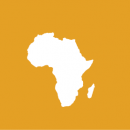Africa Watch
Food crisis in Cameroon
By Pavithra Rao
With rising food prices and so many mouths to feed, Cameroon is grappling with a serious crisis. The International Monetary Fund (IMF) reports that prices of main food items have skyrocketed this year, some by up to 20% from last year. The price of sorghum, for example, rose by 4%, maize by 5% and rice by a whopping 22%, according to the Food and Agriculture Organization.
For Cameroonians, the recent spike has come as a surprise because prices were relatively stable last year. Economists blame inflationary trends that began in 2007. Since then, the country’s rate of inflation has fluctuated between 1% and 5%. Though not alarming, fluctuations in inflation over the years appear to be having a cumulative impact on food prices this time.
Out of Cameroon’s 21 million people, eight million live below the poverty line, says the World Food Programme. The country ranks 150 out of 186 countries on the 2013 UNDP Human Development Index, which measures countries based on income, life expectancy and education. There are fears that the sharp increase in food prices will worsen Cameroon’s poverty situation.
“Soaring food prices have negative short-run effects on developing countries that depend on imports for their food security and where the vast majority of households, including in rural areas, are net food buyers,” says the International Fund for Agricultural Development. Cameroon’s food imports, notes the World Bank, comprise about 25% of total imports. In 2008 some Cameroonians vented their anger through street riots and there are fears these may happen again.
An increasing refugee population may also be exacerbating food prices, many believe. Waves of refugees from the politically turbulent countries of Chad, the Central Africa Republic and Nigeria are seeking asylum in the more politically stable Cameroon. The United Nations High Commissioner for Refugees estimates that more than 100,000 refugees have crossed over to Cameroon as of 2013.
In addition, water shortages continue to affect food production. According to the World Health Organization, rainfall lately has been low and irregular, affecting crop yields. In 2012, for example, severe drought followed by flooding throughout the Sahel region worsened Cameroon’s water problem.
The country learned some useful lessons from past food crises. In 2008, rising food and fuel prices sparked riots and looting in Yaoundé, Cameroon’s capital city and Douala, its major seaport. The government responded by creating an organization to regulate basic food supplies. The agency has had limited success as food prices continue to soar. Government is also providing subsidies for school and work programmes to alleviate suffering.
Cameroon’s Consumer Association believes that subsidies have been timely. How far these will go to lower food prices and assuage anger remains to be seen.
In sub-Saharan Africa, primary school teacher shortage on the horizon
By Tsigue Shiferaw
Sub-Saharan Africa is about to face a major shortage of teachers, says the United Nations Educational, Scientific and Cultural Organisation (UNESCO). Its newly released data show that about one third of the countries in the region will face pressure in the coming years to hire more teachers due to a rising demand for education from an increasing school-age population. As a result, the region will need about 2.1 million new teaching posts while filling another 2.6 million vacant positions, as many will leave the profession due to attrition from retirement or sickness.
Some countries are already making efforts to prevent such an outcome. Ethiopia, for instance, has been expanding its teachers workforce by an average of 11% per annum since 1999. Analysts believe this rate could enable the country to meet the challenges of a future shortage. Cameroon, Namibia and Lesotho have also taken steps to increase the number of teachers, according to the UNESCO Institute for Statistics 2013 study, “Projecting Global Teacher Needs from 2015 to 2030”. As a result, these countries should be able to attain the Millennium Development Goal of universal primary education.
Before the recent political unrest, the situation in the Central African Republic was slightly different as the country was recruiting teachers at a rate of 10% per annum. There are now fears that the ongoing fighting, if not stopped, could affect recruitment efforts.
But the trend is worsening in other countries. More children in Côte d’Ivoire, Eritrea, Malawi and Nigeria will need extra primary school teachers by 2030. In Eritrea, for example, for every seven teachers recruited, 10 are expected to leave, notes the UNESCO study. On the other hand, Mauritania is catching up and may close the gap by 2015, while Djibouti faces one of the biggest challenges as only 54% of primary school-age children are enrolled.
To attain the goal of universal primary education, Djibouti will need to recruit about 17% more teachers each year between now and 2030. Many believe this is unlikely to happen because the country doesn’t have the resources to hugely expand its workforce, which means it will inevitably face an acute teacher shortage by then.
While sub-Saharan Africa accounts for 46% of the global shortage of lower secondary school teachers, the data also show that governments that have started to make serious efforts to confront the problem will be in a better position to assure quality and universal education by 2030.





















